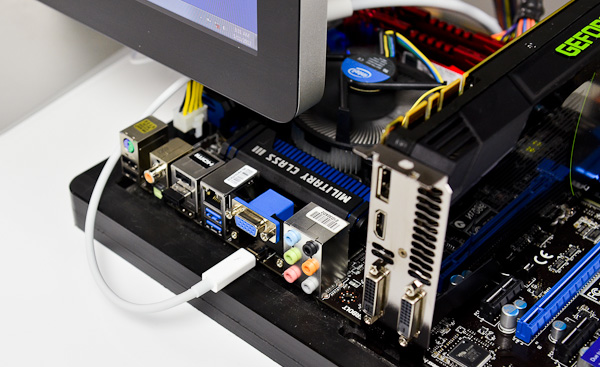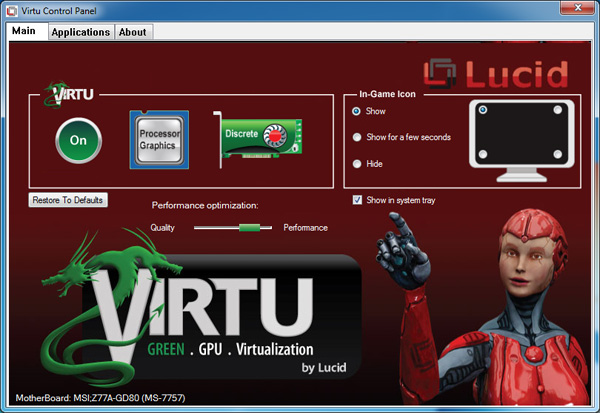A First Look at Thunderbolt on Windows with MSI's Z77A-GD80
by Anand Lal Shimpi on May 11, 2012 1:32 PM EST- Posted in
- Motherboards
- CPUs
- Intel
- MSI
- Thunderbolt
The Thunderbolt Display
The first test was hooking up Apple's Thunderbolt Display, the only Thunderbolt display device available on the market today. Although I shouldn't have been, I was a bit surprised when the display just worked. Intel's HD 4000 drove the 2560 x 1440 panel just fine and there weren't any funny issues displaying the lower res UEFI setup mode.
Despite Ivy Bridge being able to drive three independent displays, I was only able to simultaneously output to two connected displays on the GD80. All combinations of two worked however (TB + HDMI, TB + VGA, VGA + HDMI).
Once in Windows, the Thunderbolt Display's integrated GigE, Firewire and other controllers started popping up. Unfortunately Apple doesn't offer a direct download package for Thunderbolt Display drivers. You can either hunt down the controllers/drivers on their own, or you can build a Windows Support (driver) package using a Mac and the Boot Camp Assistant. I'd much rather Apple just offer an easy route for non-Mac Windows users to take advantage of the Thunderbolt Display as it's the only TB display on the market, but I can understand the lack of motivation there.
With the Boot Camp drivers installed, I got working GigE and Firewire 800. The Thunderbolt Display's integrated USB hub gave me issues however. Anything I plugged into it would either partially work (e.g. my mouse was detected but moving the cursor was far from smooth) or not work at all (e.g. my attached USB keyboard never worked). The other issue with the Thunderbolt Display is you get no brightness control, which can be a problem given how bright the panel gets. I've seen reports of people getting brightness control working via software tools but the solutions don't seem permanent.
Apple's Thunderbolt Display definitely works, but Windows users will likely want to wait for a Thunderbolt display that is built specifically with Windows in mind.
Virtu and Thunderbolt: It Works
From a software perspective, Thunderbolt is treated just like another display output driven by Intel's processor graphics. I installed a GeForce GTX 680 along with Lucid's Virtu GPU virtualization software to see if I could use the 680 for gaming but drive the display using Intel's processor graphics and the Thunderbolt port. The setup worked flawlessly.
Virtu recognized the configuration immediately once I had NVIDIA's drivers installed, and I was able to run the 680 headless - using only the Thunderbolt port to drive the external display. Intel's HD 4000 powered things in Windows, while the 680 kicked in for games.













98 Comments
View All Comments
ggathagan - Friday, May 11, 2012 - link
Did you read the second page?Ivybridge chipsets utilize Virtu software to allow you to switch between the IGP and a discrete GPU without having to physically switch the display connections.
The display can be attached to either the motherboard connection or the dGPU connection and Virtu will allow you to use use the dGPU for gaming, while utilizing the IGP for less strenous uses.
As Anand clearly stated, you can use the TB connection for your display and that process still works properly.
Zoomer - Friday, May 11, 2012 - link
HD 4000 as clearly mentioned in the article.Death666Angel - Monday, May 14, 2012 - link
And GTX680 when firing up games....Ujjwal Tiwari - Friday, May 11, 2012 - link
I couldn't quite grab it from the article, Was it possible to play games from gtx 680 on mac display through TB port? Or was another normal display used to connect to graphics card? And how in the hell are we supposed to run gpu intensive apps through HD 4000 only?? (Assuming we use mac display as only display?)Zoomer - Friday, May 11, 2012 - link
Yes with Virtu.ggathagan - Friday, May 11, 2012 - link
Yes.No.
Read the second page and read up on Ivy Bridge and Virtu!
The only difference between this and a non-TB motherboard is that you have yet another connection that can be used for your display.
Nothing else changes with regard to how the IGP and dGPU work on an Ivy Bridge board.
ggathagan - Friday, May 11, 2012 - link
If there's one market besides mobile where ThunderBolt could really take off, it's in the corporate world.Just think how inexpensive it could be if someone like Dell or HP were to take the following approach:
You put out a line of computers and monitors where all the connectivity is at the display.
There would no longer be any need to build network, USB, Firewire or even sound into the motherboard.
This reduces the computer itself to nothing more than the CPU, memory, GPU and storage.
Even the storage could be separately housed.
That makes for a tiny foot print and your customers can now upgrade their computers to the latest-and-greatest CPU/GPU with no more effort than it takes to plug in the TB cable and the power cord.
This is also applicable to the HTPC community if someone ends up marketing TB-equipped TV's.
descendency - Saturday, May 12, 2012 - link
Wow. Cool. I'm not really interested in this in the desktop area, but a laptop... yes. Just yes.If Lenovo reads this, an Thinkpad X2xx tablet with this is a day 1 pre-order. I can't imagine how awesome this will be when it gets into the market at large.
Wardrop - Saturday, May 12, 2012 - link
Making the monitor the interconnect hub for a computer does make sense. You're more likely to move around a computer than a monitor. Portability doesn't just refer to laptops and using your computer away-from-a-desk. Portability for me means moving a computer from one desk to another. This is especially applicable at my place of work, where I have technical requirements that exceed the capabilities of a laptop, but where I need to move between offices which have a hotdesks with monitor, keyboard and mouse.Basically, all of the logic should reside in the computer, but the monitor should act as the consolidation point for all the copper connecting your devices to your computer. I wouldn't like to see the monitor have any intelligence, with thunbderbolt (the carrier) being the exception.
Impulses - Saturday, May 12, 2012 - link
TB displays are great for laptop users but they're not a prefect solution for everyone... Any power user that has multiple displays probably doesn't care a whole lot for having a bunch of peripheral connections hanging off displays that are possibly wall or arm mounted. The holy grail for TB is still being able to offer that powerful external GPU that makes a thin and light laptop a gaming machine at home imo, but we seem to be a long way off from that.